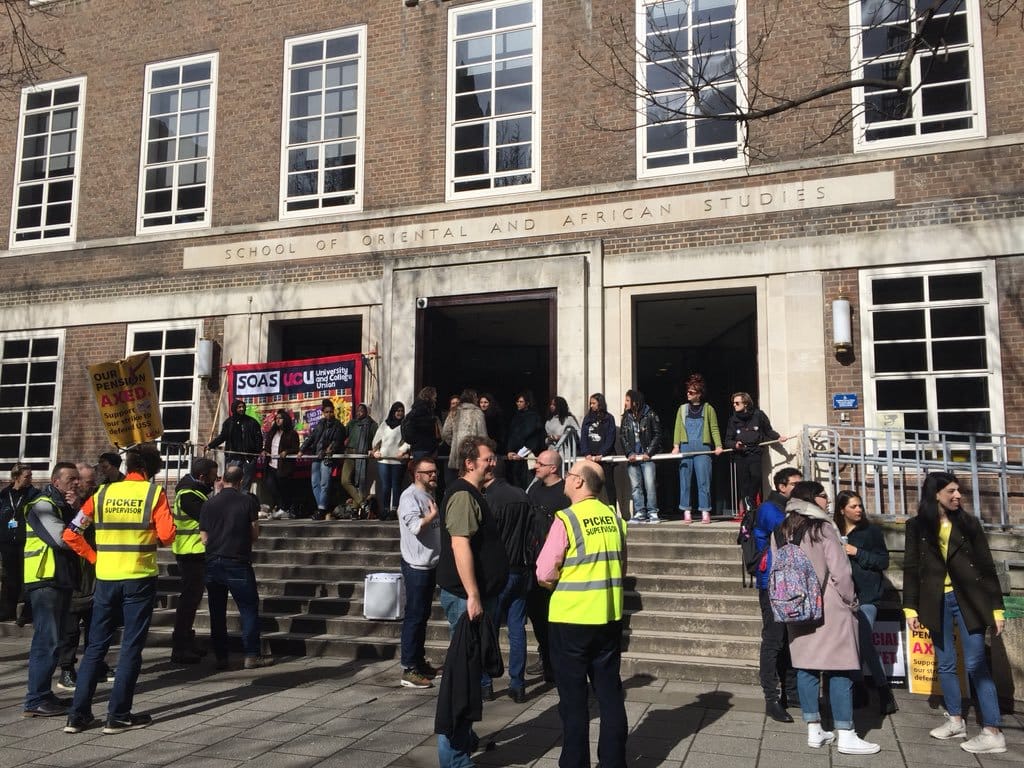Hard Picket Protesters Facing 'Weaponised' Disciplinaries for Blocking Entry to Main Building

Following the hard picket initiated on 16 March, six of the student protesters who blocked access to SOAS’ main building have been subject to the university’s disciplinary procedures over a period now spanning months.The events of the day remain disputed despite CCTV coverage, with SOAS insisting that the material can only be seen by defendants, witnesses and members of the disciplinary panels. The lack of a coherent narrative has enabled the initial environment of rumours and misinformation to continue, with the case being picked up by right-wing media outlets like The Sun and The Times who have been able to follow up several previous articles attacking SOAS student and protester Hamish Anderson. The future of the accused students remains uncertain, with Anderson currently barred from campus amid an ongoing crowd-funded legal appeal. Adding to the case’s seeming inability to be resolved soon one of the two main complainants, Professor Lawrence Sáez, passed away due to cancer on 11 September.
On the day of the alleged incidents, a group of students enacted their controversial strategy as a ‘last resort’ attempt to support the SOAS lecturers striking in their dispute with Universities UK over changes to their pensions, drawing mixed support and criticism. Forming chains with linked arms and rope, the protesters prevented access to the campus’ main building. Several members of the Students’ Union’s executive team participated in the protest, which saw several violent incidents as a number of students and lecturers attempted to push through the barrier, leading to cuts, bruises and a protestor with a dislocated leg.
The first of the events under investigation occurred at around 9:30 am, as complainant Dr Sáez arrived at the building. He describes arguing with two of the protestors before trying to access the door where he claims to have been attacked, telling a disciplinary panel that ‘there were about four people kicking me’ in his calves and shins. Eventually passing the picketers, Dr Sáez tells of arriving in his office a ‘few minutes’ after 9:50, in time to witness from his window ‘a woman wearing a dark blue headgear […] being kicked and punched by the picket line holders’, at which point he left the window to get a phone to record the events.
The individual described is fellow complainant Dr Idil Osman, a Senior Teaching Fellow in the Development Studies department. Arriving around 10:30, some half-hour after Dr Sáez placed the events, Dr Osman also began trying to gain entry, ‘walk[ing] up’ to the students and ‘explain[ing] that [she] needed to get to work’ which, in her statement, led to reasoned discussion with the students before Anderson kicked her twice in the shin. Here, she claims to have both punched and shoved him in defence, with witnesses and the defendant describing this as several blows to the face. Video available online shows the aftermath of these events, reportedly after Dr Osman left the area for around ten minutes. She and Anderson argue over who was responsible for the melee, as she threatens to ‘punch [Anderson] to death’ if she is kicked again [1]. SOAS CCTV footage is reportedly the only known recording of the contact taking place. The investigating officers, Professor Chris Brammal and Dr Hong Bo, found that footage to be unclear and inconclusive.
Dr Osman called on three witnesses to support her testimony before the panel. The first, Dr Sáez, corroborated the account of students kicking Dr Osman, though he also mentioned her being punched, an occurrence that doesn’t appear in her statement. A second staff member, Ben Mason, told an investigator that he had not seen a kick, though he described Osman’s actions as ‘definitely reactive’ with the protesters ‘goading her for ages’. The final witness, Stephen Ashwell, also told investigator Dr Bo that he had not seen Osman kicked during the fracas, expressing that her response was ‘excessive.’
In support of his version of events, Anderson requested that the disciplinary panel permit several named fellow protestors to give evidence, following assurances from disciplinary note-taker David Ogden that they would not be targeted. Investigator Professor Brammal declined to interview these witnesses, five of which are now subject to their own disciplinary investigation.
The initial disciplinary panel judged that Anderson had ‘more likely than not’ kicked both complainants, though the panel concluded there was no lasting harm and the kick ‘was not done with great force.’ With Anderson barred from accessing SOAS for 12 months, he has mounted a legal appeal, reopening the case. This process is still ongoing. Anderson alleges that the university has repeatedly violated its written procedures and frequently cancelled its scheduled meetings. Fellow protestors echo his claim that the university is ‘using the process as a form of intimidation.’
The day’s events appear to have had far-reaching consequences on the university as a whole, surfacing in explanations of the recent distancing between some campus-based grassroots campaigns and the current SU executive, amid allegations of the latter’s lack of support and solidarity for the protesters.
Dr Osman could not be reached for comment. A SOAS spokesperson reaffirmed their policy not to comment on ongoing cases.
JULIUS OGUNLEYE, THIRD YEAR ECONOMICS AND DEVELOPMENT



